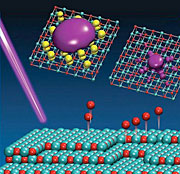- Number 336 |
- May 2, 2011
Oxygen atoms on the move

A new way to accelerate and
remove oxygen atoms from
thin films of calcium oxide.
Scientists from DOE’s Pacific Northwest National Laboratory, University College London, and Tohoku University devised a way to excite oxygen atoms and cause them to flee thin films. The team used a PNNL-developed technique called reactive ballistic deposition to grow a calcium oxide film. Next, they used laser pulses to excite the film, producing highly energetic atoms. These energized oxygen atoms left the surface at speeds many times greater than the speed of sound. With specialized time-of-flight techniques, the team measured the energy involved and the number of oxygen atoms that fled the surface.
This new technique can create tailored surfaces. Designing structures at the atomic scale, manipulating atom placement, could be valuable for solar cells, ever smaller electronic devices, and certain catalysts. DOE’s Office of Basic Energy Sciences funded the research, which was done at DOE’s EMSL, a national scientific user facility.
[Kristin Manke, 509.372.6011,
kristin.manke@pnl.gov]
